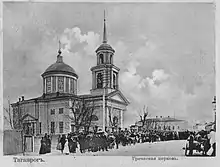Greek Church and Greek School (Taganrog)
| The Greek Church of Sts Constantine and Helena | |
|---|---|
 The Greek church (Sts Constantine and Helena church) on an old postcard | |
| Religion | |
| Affiliation | Greek Orthodox |
| Status | Demolished in 1938 |
| Location | |
| Location | Taganrog, Russia |
| Architecture | |
| Completed | 1830 |
| The Greek School Греческая школа | |
|---|---|
| Address | |

| |
Ulitsa Grecheskaya, 54 | |
| Information | |
| Type | parochial school |
| Religious affiliation(s) | Greek Orthodox |
| Patron saint(s) | Saint Constantine and Saint Helena |
| Opened | 1862 |
| Closed | 1882 |
| Graduates | Anton Chekhov, Nikolai Chekhov |
| Affiliation | The Church of the Saint Constantine and Saint Helena in Taganrog |
History of the Greek Church
The construction of the Greek church was started in 1781 and in March 1782 the church was already consecrated.[1] The first service was held by the priest Nikita Aguros. When leaving Taganrog in 1826, the Empress consort of All the Russias Elizabeth Alexeievna (Louise of Baden) left the church money for a reconstruction.
In 1830 a new stone church was built to replace the wooden one. The public worship was made in Russian and in Greek. During the Siege of Taganrog, from the territory of the church the Cossacks and the volunteer corps repulsed the attack of the British and French landing party.
The church was shut down in 1938 and was demolished soon after. In the 1940s, a block of flats was built in the same place.
Greek School
The wooden building behind the Greek church was built in early 19th century, and was later covered with bricks. In the early 19th century the building was used by the Greek city council, which co-existed with the Municipal city council. In the 1850s the building was returned to the Greek church, and in 1862 was opened as a parochial school for preparation of choristers.
The Greek school was financed by the Greek Church of Taganrog and by rich Greek merchants. Among the disciplines were Greek language, theology, mathematics, history, calligraphy, and singing. In 1882 the building was given back to the clergy of the Greek church
Anton Chekhov attended the school in 1866-1868, until at the age of eight he was sent to the Gymnasium for Boys.
After the October Revolution, the building was given to the families of factory workers, and the front and layout of the former school were completely changed.
Photos
 The Greek Street (Ulitsa Grecheskaya) in Taganrog with Greek Church of Sts Constantine and Helena on the right
The Greek Street (Ulitsa Grecheskaya) in Taganrog with Greek Church of Sts Constantine and Helena on the right The former Greek school (photo of 2008)
The former Greek school (photo of 2008)
External links and references
- Чеховские места в Таганроге. Путеводитель. Таганрог, 2004
- Г.Н.Орлов, Л.И.Найговзин, А.А.Цымбал "Памятники архитектуры, истории и культуры Таганрога на старых открытках и фотографиях". Таганрог. Лукоморье, 2008


